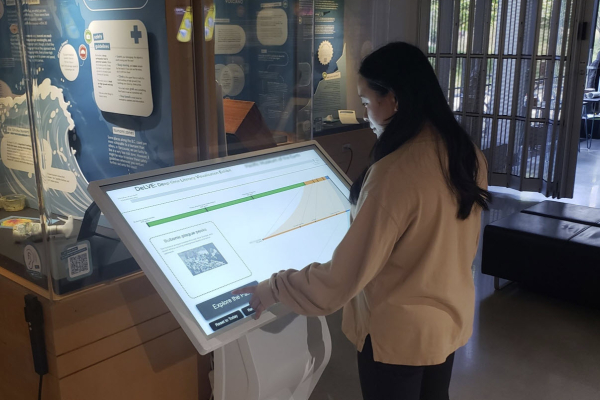
How earth went from microbes to microchips: UBC researchers created an interactive “deep time” visualization
A multi-disciplinary collaboration between University of British Columbia researchers and several local museums has resulted in a paper being accepted by IEEE VIS that focuses on visualizing deep time, a concept often difficult to grasp.
Mara Solen, one of the lead researchers, shared insights into the project and its development, as well as the impact it has had so far. “The project began in May 2022, sparked by an idea from our co-researcher, Dr. Laura Lukes, a professor in the Earth, Ocean, and Atmospheric Sciences Department. Dr. Lukes already had existing connections with local museums and the concept of deep time was something Laura recognized as needing more educational focus," said Solen.
Lukes and Solen, along with Solen’s PhD supervisor, Dr. Tamara Munzner, a visualization expert in the UBC Computer Science Department, brought the project to life after it received funding from a UBC STAIR grant (Support for Teams to Advance Interdisciplinary Research). The result was twofold: first, a novel exhibit that helped museum visitors understand the vast timescales of Earth's history through interactions with digital timelines of significant events, and second, a research paper that explains the outcomes: DeLVE into Earth's Past: A Visualization-Based Exhibit Deployed Across Multiple Museum Contexts.
Three museums, billions of years
The interactive exhibit was first deployed in the Beaty Biodiversity Museum in the spring of 2023, followed by Science World and then UBC’s Pacific Museum of the Earth in the fall. Visitors can engage with the exhibit by pressing buttons that progressively reveal historical events on increasingly expansive timelines, helping them relate familiar, recent events to those from millions or billions of years ago. "We built the exhibit in a way that shows more recent events first," explained Solen. "With each click, the timeline zooms out, showing older and older events, until you eventually get to things like the formation of the Earth or the rise of dinosaurs."
Dr. Munzner added, “We developed a way to scaffold learning about huge time scales, so that people who didn't already understand the mathematical framework behind logarithmic thinking could develop intuitions about it through visuals and interaction. We learned a lot more about how the context in which a visualization is seen, affects how people respond.”
Context and setting really matter
As with many public-facing exhibits, the degree of visitor engagement varied depending on the setting, which was a key component of the study. Science World, with its family-friendly atmosphere, saw a different kind of interaction compared to the more academically inclined, education-seeking audience at the Beaty Museum. "At Science World, we saw a lot of younger kids interacting, but many didn’t have the reading level required, and their attention spans were shorter. The Beaty Museum was different, where people arrived expecting to learn and read more," Solen said. "There’s a big difference in how people react to the same exhibit based on where it’s placed, and that’s what our research focuses on: context.”

Solen emphasized that while the exhibit at Science World might not have attracted as much sustained interaction as in the Beaty Museum, it still garnered significant attention. "We tracked logs of every button press, and over a year, we had about 10,000 interactions. Science World had by far the most interactions simply because of how many visitors they get," she noted.
The research team tracked more than digital logs to measure engagement—they also conducted observations in the museums. Solen spent hours sitting in the exhibit space, watching how people interacted with the display. "I saw a wide range of behaviours. Some people would just glance and walk by, while others would spend a full five minutes going through all the information. Getting people to engage for that long in a museum setting is pretty impressive, considering how fast-paced museum visits usually are," she said.
While the exhibit has already been a success, the research is far from over. "We’re continuing to gather data from the exhibit's ongoing deployment. One interesting avenue for future work is analyzing trends over time in how people engage with the exhibit," Solen said. The team is also considering redeploying the exhibit to new locations within the museums, possibly with new datasets and themes tailored to different settings. These adjustments could help the researchers gain further insights into how various environments impact visitor interaction.

UBC Computer Science graduate
Looking ahead, Solen plans to continue her research on visualization. Her next project will focus on fitness data sharing, particularly how app platforms like Strava are used to share exercise information.
Reflecting on the impact of the DeLVE project, Solen expressed satisfaction with what they’ve achieved. "This has been the biggest project of my research efforts so far. It’s rewarding to see it out in the world and have people interact with it. It took two and a half years, but it feels great to see it come to fruition," she said.
Open source software means easy adoption for museums worldwide
Dr. Munzner said, “We're excited that several museums in Vancouver have already welcomed the exhibit into their spaces. We've made the underlying software available as open source, with really easy ways to load up custom datasets for it to show, so that it's very easy for any museum anywhere in the world to adopt.”
This research highlights the power of interdisciplinary collaboration, where expertise along with the power of visualization, can come together to create innovative educational tools. DeLVE has already made an impact on museum education. With continued research and development, it’s likely that this exhibit and others like it, will only grow in helping the general public to better understand and interact with multi-layered scientific concepts.
Read more about Mara Solen
Read more about Dr. Tamara Munzner